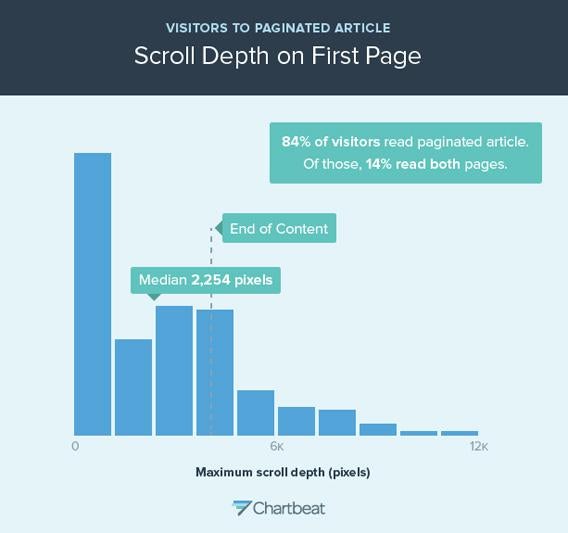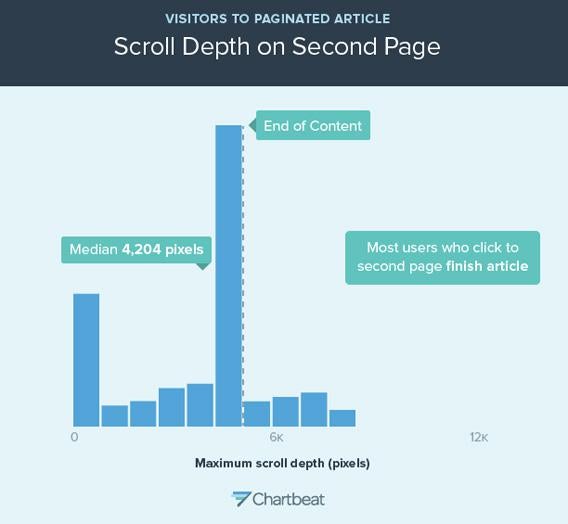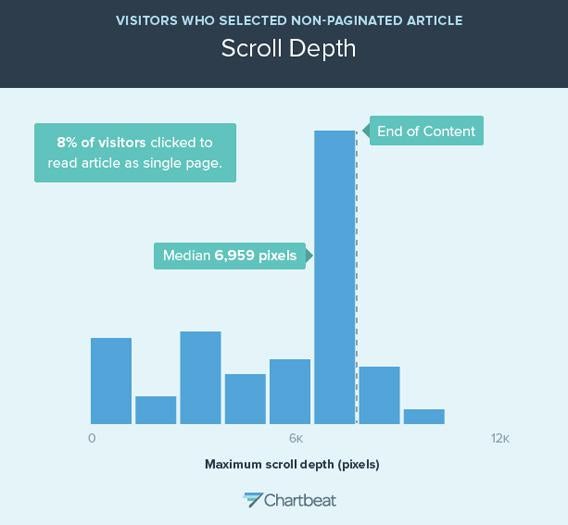Last week I challenged readers to get to the end of my column. OK, right, I do that every week, but this time the challenge was explicit. The Web traffic–analysis firm Chartbeat had provided me with stats showing that most people don’t scroll all the way through online articles. At Slate, 38 percent of readers who land on a page immediately bounce away, and 5 percent of those who are left never scroll at all. Most others give up in the middle. The median scroll length at Slate is about halfway through an article, and across the Web it’s just slightly more. Most of the people who are reading this sentence are getting ready to press the Back button. (You guys suck.)
But it’s not just that people aren’t reading the whole thing; they also seem to be sharing articles they haven’t fully read. Chartbeat—whose software can measure where on the page your browser is pointed on a second-by-second basis—shows that there’s little relationship between scrolling and tweeting. Articles that generate a lot of scrolling down the page don’t necessarily generate many tweets, while much-tweeted articles aren’t necessarily much-read. If someone is telling you to read something, beware: There’s a good chance he hasn’t read it himself.
My column carried the headline “You Won’t Finish This Article.” So, did you finish? Why or why not? If you didn’t, was it because the piece (like most Slate pieces) was split up into multiple pages? And does it matter that you didn’t finish—is it a big deal that people aren’t reading to the end?
Those are a few of the questions I got from readers. (I mean, “readers.”) Luckily, Chartbeat’s software was monitoring how people navigated through the column. So now, thanks to the company’s data, I can answer.
The first and most important point: Yes, you did finish that article! Well, more of you than I’d have suspected. Take a look at these two graphs, which show how people scrolled through pages 1 and 2 of the piece. (My piece was split into two pages.)

Courtesy of Chartbeat

Courtesy of Chartbeat
The X axis in these charts represents the depth of the story—from the start of the page, at 0 pixels, to 12,000 pixels, the very bottom of the page. The Y axis represents the share of readers who stopped scrolling at a particular spot on the page. (These graphs exclude readers who “bounced,” meaning they didn’t spend any time on the page at all.)
As you can see, on the first page, there’s a huge spike at 0 pixels. That spike represents 41 percent of readers. This means that of all readers who landed on the page, nearly half did not scroll at all. This is extremely sad but not surprising, and it certainly does not say anything about my ability to write an inviting lead paragraph. As the graphs in the last column showed, people who don’t scroll make up a huge share of readers on every Slate page and, for that matter, pretty much everywhere across the Web as well. I am not a terrible writer. I’m not.
But what’s most interesting about these graphs is what happens after 0 pixels. On the first page, the second-largest spikes occur right before the jump, where you’ve got to click to go to the second page. (That’s the spot marked “End of content”; about 32 percent of readers made it to that point.) And on the second page, the largest spike, representing 43 percent of readers, is again right at the end of the story. This means that, of the readers who did start scrolling—i.e., of those who didn’t bail on the story right at the top—a whole lot of people stuck with the piece. If you weren’t turned off by the beginning of the story, you tended to read the whole thing. This outcome contradicts the trend I showed last week. People don’t read through most Slate articles, but this time, on this one article, they seemed to read a lot.
The most likely explanation for this is that I am an awesome writer. The second, less plausible explanation is that there was some kind of weird psychological effect going on. The story was called “You Won’t Finish This Article,” so people might have been scrolling just to prove me wrong. They may also have been skipping to the end of the piece just to see if there was some kind of Easter egg there. So either they were only reading out of spite, or they weren’t actually reading. Not that I care which it was; if you got to the end of the article, I won. (Chartbeat can actually measure the average scrolling speed, but I didn’t get those numbers for this piece.)
The next issue: pagination. As I argued last year in a piece you probably read the first few words of, I hate the widespread practice of breaking up Web articles into multiple pages: “It shows constant, quiet contempt for people who should be any news site’s highest priority—folks who want to read articles all the way to the end,” I wrote. (I called on Slate’s editors to stop paginating the site. Click Page 2 to see how much influence I have around here.)
After my piece last week, many people wrote in to say that it was pagination that turned them away from Slate articles. “Should anyone be surprised to see most readers defecting before the end of online stories, when simply displaying the end of those stories requires laboriously clicking buttons?” asked one.
It’s a good question. And at first glance, Chartbeat’s data does seem to suggest page-splitting might be preventing people from getting to the end. But that’s wrong; as you dig deeper into the company’s numbers, it turns out that you can’t blame pagination for our poor attention span. (Which is not to say that pagination is OK. It’s awful.)
First, note that there’s nothing at the start of a Slate page to indicate that it’s been paginated. So if you quit the story right at the start, before scrolling, it couldn’t have been because you hate pagination.
According to Chartbeat, 14 percent of readers clicked from the first to the second page, and another 8 percent clicked from the first page to the single-page view. In all, then, about 22 percent of readers clicked to get the whole story. That’s low. But only a third of the people who read the first page made it to the jump point at the bottom, so most of the readers who got to that point did click to go on—and most of those people did finish the article. All of this is a long way of saying: If you made it all the way to the jump point, you probably weren’t bothered by it so much that you stopped reading.
There’s another way of showing that pagination is not to blame for our failure to read to the end. There are two ways that readers might have gotten to the single-page view of my column. One way is if they’d clicked the Single Page button from the first page. The other is if they arrived from a link posted elsewhere that took them directly to the single page, bypassing the first page entirely. Because I hate paginated articles, when I share my articles on Twitter and Facebook, I always post the single-page view. This sets up a natural experiment: When people land directly on the single-page view, do they read more than people who land on the first page?
The answer: Nope! Actually, people who only saw the single-page view read less of the story than those who landed on Page 1. Here’s a chart of people who came directly to the single-page version of the article:

Courtesy of Chartbeat
That spike at 0 percent is enormous—60 percent who landed on the one-page view didn’t scroll at all. The median scroll length was only 700 pixels, which is only about two paragraphs. Most readers didn’t finish the article. This is far worse than the performance of page 1, where a third of readers made it to the jump. (Yes, there are potential complicating factors here: A lot of these single-page readers were coming from social networks where I’d posted the link, while the people landing on Page 1 were mostly coming from Slate’s home page. It’s possible that social-network browsers just aren’t very interested in reading Slate articles, but people on Slate’s home page are.)
Finally, here’s a chart showing the behavior of people who purposefully clicked to get to the single-page view (rather than those who got to the single-page view from an outside link):

Courtesy of Chartbeat
These were the best readers of all. Of the folks who clicked to get to this page, 44 percent read all the way to the end of the story, and only 12 percent quit reading without scrolling. That makes sense: You wouldn’t have clicked to read the single-page view if you weren’t interested in the topic. The bad news is that only 8 percent of all visitors to the piece clicked to see this page. These super-interested readers are wonderful, but there are tragically few of them.
The last question that readers raised was whether any of these findings tell us something new. I argued that the fact that people aren’t reading stories shows that we live in the “age of skimming,” one that extended far beyond the Web. From ebooks to streaming movies and TV shows, we’re all just sampling at an endless cultural buffet.
Or maybe I was being too pessimistic. Several readers pointed out that people have always skimmed stuff. Readers bailed on stories back in the days of newspapers, too. Indeed, skimming informs everything about how newspapers are designed: Headlines, pull quotes, captions, story placement and the inverted pyramid news-writing style are all meant to give readers the gist of a story even if they don’t read the whole thing. In 2007, the journalism research group Poynter did an eye-tracking study comparing people who read news stories online to those who read print newspapers. They found that, on average, people who read a Web version of a story read slightly deeper than people who read the print version.
So things are bad now, but they were actually worse before. It’s not that people aren’t reading the full story online—they’ve never read the full story! Yay?
Finally: Before you run to the Comments section to tell me how much you love me, study the graphs above. Every single one shows that only a tiny percentage of readers look at the Comments section. Happy commenting!